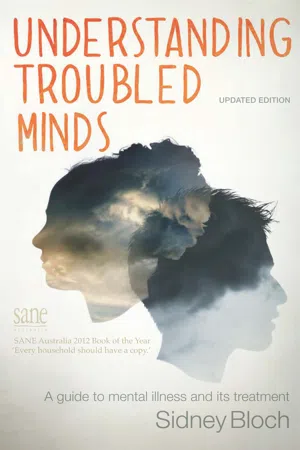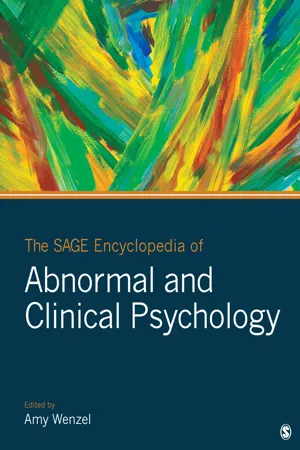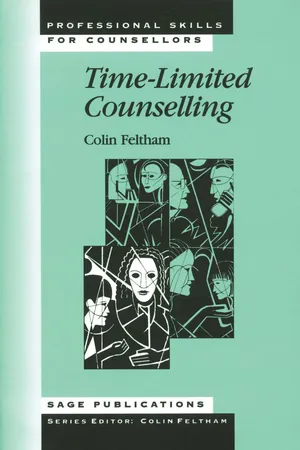Psychology
Types of Therapy
Types of therapy in psychology refer to the various approaches and techniques used to address mental health issues and improve well-being. Common types include cognitive-behavioral therapy (CBT), psychodynamic therapy, humanistic therapy, and family therapy. Each type of therapy has its own theoretical foundation and methods for helping individuals cope with and overcome psychological challenges.
Written by Perlego with AI-assistance
Related key terms
5 Key excerpts on "Types of Therapy"
- eBook - ePub
Understanding Troubled Minds Updated Edition
A guide to mental illness and its treatment
- Sidney Bloch(Author)
- 2014(Publication Date)
- Melbourne University Press Digital(Publisher)
Defining psychotherapy is tricky for at least four reasons. Firstly, many psychological treatments are available, each with its own rationale and methods. Secondly, however well planned, these treatments are to a varying extent unpredictable in their application. The reasons for this are obvious once you think about the nature of the process. Psychotherapy is influenced by many unique features, among them the patient’s type of personality, the presenting problems, motivation for change and capacity for reflecting about oneself. Thirdly, treatment is also influenced by therapist’s personal qualities and the values they espouse; in this regard, the therapist–patient relationship is all-important. Finally, goals of treatment range from relief of symptoms (as in behaviour therapy) to radical personality change (as in insight-oriented approaches like psychoanalysis).The task of definition is eased by referring to ‘the psychotherapies’, since we are concerned with an array of treatments, applied for varied purposes. (Counselling is related to psychotherapy but usually regarded as distinct from it—I shall address it briefly later in the chapter). All psychotherapies involve two foundational features. The first is a relationship between a trained health professional (psychiatrist, psychologist and social worker are the principal groups) and a person needing help to deal with psychological distress (for example, depression, anxiety, guilt, poor self-esteem, unresolved grief) and disturbed functioning (for example, failure in maintaining intimate relationships, marital strife, poor coping with stress). The second feature is the planned, systematic application of specific psychological principles.Factors that unite the therapies
This succinct definition covers all psychotherapies, although the person’s particular difficulties, and the psychological principles applied vary considerably. On the other hand, certain features unite the psychotherapies. These common basic factors were originally formulated by Jerome Frank, a pioneering psychotherapy researcher, in the early 1970s. Given the systematic studies of his group, we can conclude confidently that these factors are necessary but not sufficient for the practice of the psychotherapies, and that we also need to incorporate additional psychological principles. - eBook - ePub
Fundamentals of Mental Health Nursing
An Essential Guide for Nursing and Healthcare Students
- Andrew Clifton, Steve Hemingway, Anne Felton, Gemma Stacey(Authors)
- 2017(Publication Date)
- Wiley-Blackwell(Publisher)
Table 17.1 ).Table 17.1Four main categories of mental health therapiesBehaviouralPsychoanalyticalHumanisticArtisticAcceptance and commitment (ACT) Behavioural therapy Cognitive analytical therapy (CAT) Cognitive behavioural therapy (CBT) Cognitive therapy Jungian therapy Psychoanalysis Psychoanalytical therapy Psychodynamic therapy Existential therapy Gestalt therapy Human givens therapy Person centred therapy Psychosynthesis Reality therapy Solution focused therapy Transactional analysis Transpersonal psychology Art psychotherapy Drama therapy Music therapy We would disagree with some of the locations because if there was an ‘integrated’ column some of them could be moved into this and we notice that dialectical behavioural therapy (DBT) is absent. If you drill down further into the internet you can find 146 therapies listed, which include ‘nude therapy’ and ‘vegetotherapy’. Furthermore, Powers (2002) notes an estimate of as many as 500, thankfully giving a helpful critique of ‘common factors’ associated with the therapeutic encounter. For the purposes of this chapter we want to help you explore the interventions that are prevalent in the NHS and that you are therefore likely to meet in practice.The relationship is everything
As you will discover there are many important facets to managing a positive therapeutic relationship, not the least being the core conditions from humanism. The relationship has a foundation in the term ‘alliance’ where the quality of the alliance can be seen to rest on the extent that the client and therapist agree on ‘tasks’ and achieving ‘goals’ and the ‘quality of the bond that develops between them’ (Keijsers et al - eBook - ePub
Counseling and Psychotherapy
A Christian Perspective
- (Author)
- 2011(Publication Date)
- Baker Academic(Publisher)
However, cognitive therapy is self-reported as the primary theoretical orientation by 28 percent of clinical psychologists and 29 percent of counselors (the highest percentage for counselors). Only 23 percent of counselors selected eclectic/integrative therapy as their primary theoretical orientation. Judith Todd and Arthur Bohart (2006) note that while eclecticism is the most popular approach among practicing psychotherapists, cognitive therapies and theories are now the dominant therapeutic orientation in many professional contexts including university clinical psychology programs. Prochaska and Norcross (2010) have also summarized the main findings of a Delphi Poll they conducted with sixty-two expert panelists; its composite ratings indicate what will happen in the field of psychotherapy over the next ten years. In terms of primary theoretical orientations of the future, cognitive behavior therapy was ranked first for the greatest increase over the next decade, followed closely by culture-sensitive/multicultural therapy, cognitive therapy (Beck), interpersonal therapy (IPT), technical eclecticism, theoretical integration, behavior therapy, and systems/family systems therapy. There was also consensus that psychotherapy will become more directive, psychoeducational, technological, problem focused, and brief in the next ten years. One of the major predictions concerns the length of therapy: long-term therapy will significantly decrease, while short-term therapy will become predominant. Major Types of Mental Health Practitioners and Practice Settings There are over a dozen major types of mental health practitioners in the United States who may provide counseling and psychotherapy. Les Parrott lists the following (see 2003, 14–16): 1. Psychiatrists are medical doctors who have specialized training in the diagnosis and treatment of mental disorders. They are qualified to prescribe psychotropic medications and can practice counseling and psychotherapy - Amy E. Wenzel(Author)
- 2017(Publication Date)
- SAGE Publications, Inc(Publisher)
The major psychotherapy orientations differ in their approaches to validating their methods. Psychodynamic therapists tend to view their work as akin to deciphering an ancient language, staging a dramatic production, or understanding the subtext, nuances, or semiotics of poems or novels, as opposed to using techniques that explain the transmission of nerve impulses or assess which crops do best with certain fertilizers. Behaviorally oriented therapists are more interested in studying therapeutic techniques scientifically in randomized controlled trials because their tradition stems from experimental psychology and cognitive neuroscience.Recent developments in evidence-based practice go beyond simply favoring empirically supported treatments such as interpersonal psychotherapy and cognitive behavioral therapy and emphasize the three interacting components: (1) research evidence, (2) clinical expertise, and (3) clients’ characteristics and preferences. All present significant challenges for assessment, but addressing all three components thoroughly is essential to providing clients with optimal care.Psychotherapists follow a variety of avenues to knowledge, each with its disciplined approach to answering important questions about mental health and how best to alleviate distressing and impairing conditions. Differences in opinion on how best to advance the field and provide the best care to clients continue to enliven discussion in the professional literature on psychotherapy.Geoffrey L. Thorpe- eBook - ePub
- Colin Feltham(Author)
- 1996(Publication Date)
- SAGE Publications Ltd(Publisher)
It is useful for practitioners of time-limited counselling or therapy to have an overview of approaches in this field, in part so that they have a background knowledge of approaches before them but also because a degree of eclecticism is arguably necessary (Garfield, 1995; Pollin, 1995). These approaches can be roughly divided into three types of model.1 Models adapted or designed to be relatively brief, although not necessarily having a pre-set time limit (e.g. the short-term dynamic therapy of Malan, Davanloo and others; Budman and Gurman’s interpersonal-developmental-existential (IDE) approach). 2 Models which naturally lend themselves to brief or time-sensitive work (e.g. behaviour therapy, cognitive therapy, rational emotive behaviour therapy, multimodal therapy, reality therapy, Egan’s three-stage approach, solution-focused brief therapy, neuro-linguistic programming). 3 Models which are purposefully designed to be short-term and time-limited (e.g. Mann’s 12 session model, cognitive analytic therapy, single-session therapy, the two-plus-one model, contextual modular therapy). Certain approaches, such as transactional analysis, experiential psychotherapy, dramatherapy and focused expressive psychotherapy can be adapted contractually to address either short-term, focused agendas or more long-term personal growth work (see also Elton Wilson, 1996). Here, I oudine very briefly a selection of relevant approaches, with some references given for readers who wish to investigate them in greater depth. Fuller accounts of comparative models can be found in Budman (1981), Wells and Gianetti (1990) and Budman et al. (1992).Short-term dynamic therapy
Ironically, it is the tradition that most obviously espouses long-term psychotherapy which has also generated some of the earliest bids for meaningful short-term therapy. From many of Freud’s early brief cases to Ferenczi’s active therapy, Rank’s will therapy, Skekel’s focused therapy, Alexander and French’s focus on the corrective emotional experience, the psychoanalytic tradition has also spawned Sifneos’s anxiety-provoking therapy, Mann’s time-limited psychotherapy, Balint’s focal psychotherapy, Malan’s brief psychotherapy, Davanloo’s intensive short-term dynamic psychotherapy and Wolberg’s eclectic short-term psychotherapy (Flegenheimer, 1982; Molnos, 1995). Obviously there are many differences between these approaches but I intend here to dwell more on the commonalities.
Learn about this page
Index pages curate the most relevant extracts from our library of academic textbooks. They’ve been created using an in-house natural language model (NLM), each adding context and meaning to key research topics.




